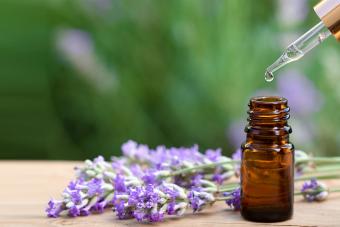
Making essential oils at home can be an easy to complex process, and it can take anywhere from a few hours to weeks depending on the method you choose. Pure essential oils have been used for beauty, skin care, and medicinal purposes since ancient times, and you can use them in feng shui to encourage positive chi energy and luck. Pure essential oils are distilled and potent, so they are most-often added to carrier oil to protect the skin. Learning how to make pure essential oils is a complex process, while using an easy method results in infused or dilute essential oils which suffuse the scent of the plant material. Keep your goals in mind as you select your method.
Learn How to Make Essential Oils at Home (Easy and Difficult Methods)
There are five methods for making essential oils at home depending on the equipment you have available, the end product you'd like, and how much time you wish to spend.
- Slow cooker (dilute, infused oil)
- Oven (dilute, infused oil)
- Sunlight (dilute, infused oil)
- Vodka (pure essential oil)
- Home distillation (pure essential oil)
The vodka and home distillation methods are the most complex, but they generate a pure essential oil using solvents and distillation. The other methods distill the plants' essence, but the end result are essential oils diluted by carrier oils.
Supplies for Making Essential Oils
You need the following items for any of the methods of making essential oils at home:
- Fresh flowers, herbs, spices, or citrus peels of your choice
- Carrier oil - The following are the most popular choices of these light scented oils:
- Olive oil
- Sweet almond oil
- Jojoba oil
- Peanut oil
- Sunflower oil
- Coconut oil
- Unbleached cheesecloth, muslin, or fine gauze
- Plastic food storage bags that zip shut
- A mortar and pestle or wooden mallet
- Wide-mouthed jar, such as Mason jar
- Dark colored storage bottles; cobalt blue, dark amber, or dark green are good choices
How to Make Essential Oils (Easy Methods)
How you make the oils depends on the process you choose, but there are some basic steps that are necessary in all easy methods. Each of these techniques require no specialized equipment, but the results aren't pure essential oils; rather, they are plant essences in a carrier oil.
Basic Steps for Making and Storing Dilute Essential Oils at Home
- Choose the method (below) to make your essential oil and follow it.
- Strain the resulting mixture. Using unbleached cheesecloth, muslin, or gauze, strain the mixture into a dark colored glass storage jar or bottle. Discard the materials and keep the oil.
- Label and date the container.
- Store the essential oil in a place that is cool, dark, and dry. Most homemade essential oils have a shelf life of six to nine months depending on the specific blends.
Slow Cooker Method
This method is easy and requires little hands on work after you've measured your raw materials. It takes about eight hours, and the result is a dilute essential oil in which the plant essences have been infused into the carrier oil.
- Place the oil and the herbs in a small slow cooker.
- Turn the slow cooker on its keep warm setting, approximately 140 degrees Fahrenheit.
- Cover and let simmer for six to eight hours.
Oven Process
This method is almost as easy as the slow cooker, although having your oven on does require some supervision, so you will need to be home while the oil is extracted. It takes just a few hours, and the result is similar to the slow cooker with plant essences diluted by a carrier oil.
- Preheat your oven to 150 degrees Fahrenheit.
- Place the oils and herbs in a baking dish.
- Place in the oven for two hours.
Sunlight Technique
No time to supervise and no equipment? No worries! Try the sunlight method of oil extraction. This takes the longest (about two weeks), but it is easy to do and results in plant essences diluted by a carrier oil.
- Place the oils and the herbs in a mason jar and seal the jar with a rubber ring - a metal ring will contaminate the oil.
- Place the closed jar in full sunlight for a minimum of 14 days.
How to Make Essential Oils From Dried Herbs and Flowers
Although some recipes may vary, the basic rule of carrier oil to dried herbs or dried flowers for the above methods is 1 cup of carrier oil to every ¼ ounce of dried herbs or flowers.
How to Make Essential Oils From Flowers and Other Fresh Plants
You can use any of the above methods to make dilute essential oils from fresh flowers and plants as well. If you are using fresh fragrant flowers or herbs, such as rose, lavender, or chamomile, place flower petals or herb leaves and stems in a plastic bag and lightly hit them with the wooden mallet to gently bruise the plant matter first. Add 1 cup of carrier oil for every ¼ cup of fresh flowers, herbs, or other plant materials.

Making Pure Essential Oils (Difficult Method)
The solvent and distillation methods are complex, involved, require specialized equipment, take longer amounts of time, and need large amounts of plant materials. However, the result is a pure essential oil similar to what you can buy from manufacturers.
Vodka Solvent Method
You can extract essential oils using a complex process using vodka as a solvent to extract the plant essence from the raw materials. This takes several weeks, plenty of equipment, and a large amount of raw materials, but the end result is a very pure form of essential oil without dilution. The process is outlined in the above video.
Home Essential Oil Distillation
You can also make essential oils using a homemade oil distiller to extract the oils from the plant material. It is a complex and lengthy process, but the result is pure essential oils with no dilution.
Tips for Making Your Own Essential Oils
When making your own essential oils at home, consider the following tips:
- Always start with very clean equipment; clean and sterilize jars, slow cooker crocks, etc. You can sterilize in the dishwasher.
- Although it probably seems like making large batches would be easier, it's best to make these in small batches since essential oils have a relatively short shelf life.
- Use the purest materials available; try to find organic herbs and oils.
- You can use a funnel to pour your oils into one-ounce dropper bottles for easy application.
- Always wear gloves when handling or blending pure essential oils and keep the undiluted oils from coming into contact with your skin; direct contact may cause sensitization reactions.
- Dilute pure essential oils before using them. A good rule of thumb is 2 drops of pure essential oil for one teaspoon of a carrier oil. You do not need to add carrier oil to infused oils, as they are already diluted.
- Observe basic safety rules, such as never ingesting an essential oil.
- Infused culinary oils are popular gifts but require special methods and further study to ensure product safety.
- Your essential oils are flammable, so keep them away from open flame or other heat sources.
More Resources for Making Essential Oils at Home
You can grow your own organic flowers and herbs, or you can find high quality dried herbs and flowers online.
- Mountain Rose Herbs has an astonishing array of herbs and plant materials for making essential oils that are organic and sustainably sourced.
- Bulk apothecary offers wholesale raw materials and packaging supplies.
- If you plan to distill your own oils at home, consider purchasing a home distiller that is pre-made. It is costly, but it's a good investment if you discover you prefer to make your own pure oils.
- AromaTools has bottles and dispensers for sale for your homemade essential oils.
The Art of Making Essential Oils
Although there are more than 700 types of aromatic plants used to make essential oils today, only about 40 of them are commonly used. There are also countless combinations of various blends of flowers, herbs, and spices. There are several processing methods that are simple, fun, and produce wonderfully scented oils to create harmony and balance in your home. Once you learn how to make essential oils at home, the process will become easier and your creativity will soar as you explore new plants and combinations.







